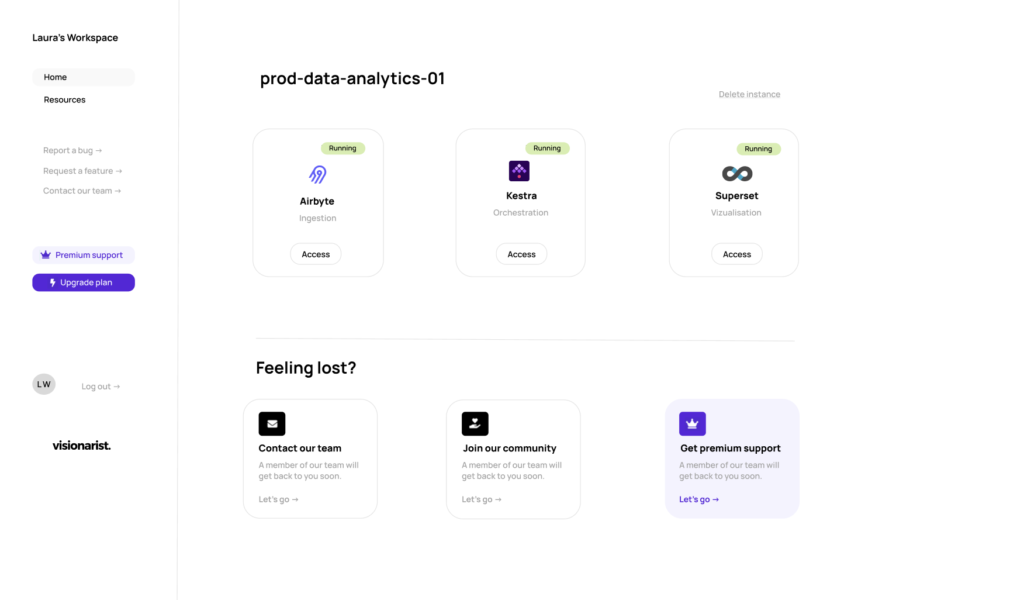Businesses are inundated with a plethora of tools and SaaS platforms. Each department might use its own set of applications for sales, marketing, customer support, and operations. While these tools are designed to streamline processes and enhance productivity, they often inadvertently create data silos – separate repositories of data that are isolated from each other.
The rise of data silos
Imagine a scenario where your sales team uses one CRM system like Salesforce or Hubspot to track leads and customers interactions, while your marketing team uses another platform to manage campaigns and analyze engagement metrics. Meanwhile, customer support team relies on a third system to handle inquiries and tickets. Each of these systems stores valuable data relevant to their respective functions, but without proper integration, this data remains fragmented and disconnected.
As businesses grow and adopt more specialized tools to cater to various aspects of their operations, the proliferation of data silos becomes inevitable. Data silos hinder collaboration between departments, impede data accessibility, and complicate the process of deriving actionable insights from the collective data.
The problem with data silos
- Lack of data consistency: different tools may use different data formats and definitions, leading to inconsistencies in reporting and analysis. For instance, a customer’s information in the CRM may differ from the same customer’s details in the marketing automation platform, causing confusion and inaccuracies;
- Reduced efficiency: teams spend valuable time manually exporting, cleaning, and reconciling data from multiple sources instead of focusing on strategic tasks. This redundancy slows down decision-making processes and increases operational costs;
- Missed opportunities: without a unified view of data across all functions, businesses risk missing valuable insights and opportunities. For example, marketing campaigns may not effectively target high-potential leads identified by the sales team due to disconnected data;
- Data security risks: managing data across multiple platforms increases the risk of security breaches and compliance issues. Each additional tool introduces potential vulnerabilities that need to be monitored and secured.
The importance of centralized data
Centralizing data involves consolidating information from various sources into a single, unified platform or repository. The centralized approached offers several benefits:
- Holistic view of data: by integrating data from disparate systems, businesses gain a comprehensive and cohesive view of their operations. This unified data allows for better decision-making and strategic planning;
- Improved collaboration: centralized data fosters cross-functional collaboration by providing teams with access to the same set of accurate and up-to-date information. This collaboration leads to more aligned goals and improved efficiency;
- Enhanced data quality: a single source of truth reduces data duplication and inconsistencies, improving overall data quality and reliability;
- Increases agility: with centralized data, businesses can respond more quickly to market changes and customer needs. By having a holistic view of their operations, they can identify trends and opportunities faster and pivot their strategies accordingly.
And to centralize your data, all you need is… a modern data stack.
The genesis of the modern data stack
The concept of the modern data stack originated as businesses began to recognize the limitations of those traditional data management approaches. With the explosion of data sources and the increasing complexity of data ecosystems, the need for a more streamlined and integrated solution became evident. Early pioneers in the field developed innovative tools and platforms that allowed for seamless data integration, transformation, and analysis. These solutions evolved into what we now know as the modern data stack – a suite of best-of-breed tools designed to work together harmoniously, providing a comprehensive solution for data management and analytics.
The modern data stack as we know it today was significantly influenced by the rise of cloud data warehouses like Amazon Redshift (launched in 2012), Google BigQuery (introduced in 2010), and Snowflake (founded in 2012). These platforms provided the scalability and flexibility that traditional on-premise data warehouses lacked. Additionally, the development of robust data ingestion tools like Apache Kafka, Fivetran, and Stitch, along with powerful data transformation tools like dbt (data build tool), allowed for more streamlined and automated data workflows.
The democratization of data analytics was further propelled by the advent of user-friendly BI (business intelligence) tools such as Looker or Tableau, which made it easier for non-technical users to access and analyze data. This ecosystem of interconnected tools and platforms, collectively known as the modern data stack, revolutionized data management by making it more accessible, efficient, and scalable.
What is really a modern data stack?
So a modern data stack consists of several key components that work together to provide a seamless data management experience. These components typically include:
- Data ingestion: tools that collect data from various sources such as databases, APIs, and external services
- Data storage: scalable and secure storage solutions for vast amounts of data
- Data processing: tools that clean, transform, and prepare data for analysis
- Data visualization and analysis: tools that enable users to perform advanced analytics, create visualizations, and generate insights
Data silos present significant challenges to businesses striving for efficiency, agility, and data-driven decision-making. By embracing centralized data management through a modern data stack, organizations can break down silos, improve collaboration, enhance data quality, and unlock new opportunities for growth and innovation.
The future of the modern data stack is here
This trend towards centralized data management is not just a passing phase—it’s the future of how businesses will operate. As more companies recognize the value of having a unified data strategy, the demand for modern data stacks will continue to grow. Visionarist is at the forefront of this movement, offering a solution that is both accessible and powerful.
We believe that data should be an asset, not a burden. By breaking down data silos and centralizing your data, you can unlock its full potential and drive your business forward. Whether you’re a small startup or a large enterprise, Visionarist provides the tools you need to succeed in a data-driven world.
Introducing Visionarist – a revolutionary modern data stack builder
Now you understand the challenges posed by data silos and the importance of centralized data management. However, implementing a modern data stack traditionally requires significant investment in terms of both time and money. Businesses often need to recruit specialized personnel, invest in extensive training, and spend up to six months developing their data infrastructure.
Now you understand the challenges posed by data silos and the importance of centralized data management. However, implementing a modern data stack traditionally requires significant investment in terms of both time and money. Businesses often need to recruit specialized personnel, invest in extensive training, and spend up to six months developing their data infrastructure.
We hear you, and Visionarist’s revolutionary platform changes the game.
Visionarist offers a solution that allows businesses to deploy a powerful modern data stack in just 30 minutes, and for free.

Key features of Visionarist’s modern data stack
- Free deployment: our platform is entirely free to deploy, with no hidden costs or subscriptions
- Rapid setup: deploy a robust data stack in just 30 minutes, significantly reducing the time to value
- User-friendly interface: our intuitive interface allows users of all skill levels to configure and manage their data stack with ease.
With Visionarist, eliminate the lengthy and costly setup times associated with traditional implementations, enabling businesses to focus on deriving insights and driving growth.
Sign up for early access and be among the first to experience the future of data management. Together, let’s revolutionize the way we handle data and unlock new opportunities for growth and innovation.


